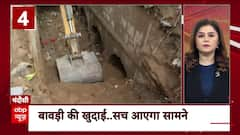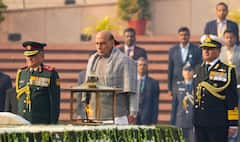Explorer
Advertisement
Checks & Balances | Places Of Worship Act: Time For A Second Look? — Governance Now
In the latest edition of CHECKS AND BALANCES, Sweta Ranjan discusses with experts whether the 1991 law should be visited (or not) in the light of developments in Varanasi and Mathura.

Gyanvapi mosque in Varanasi
Source : Governance Now
A videography survey in the Gyanvapi mosque in Varanasi this month, along with a similar survey in the mosque in Mathura permitted by a court, has brought the Places of Worship Act under focus after a gap of three decades.
In 1991, at the peak of the Ram Janmabhoomi movement, the PV Narasimha Rao government had introduced the bill, to freeze the status of all places of worship as they were on August 15, 1947 – except for the one in Ayodhya. Passed by Parliament, the Places of Worship Act aimed to put a lid on controversies that usually claimed certain mosques were built on top of, or after destroying, Hindu temples. Tempers were running high then, there were communal clashes in many parts of India. The Ayodhya temple movement had led to demands for a similar consideration of the two mosques in Varanasi and Mathura.
The Act sought to maintain communal harmony in the long run. The then Home Minister SB Chavan, who introduced the bill, had said that it would effectively prevent any new controversies from arising in respect of conversion of any place of worship.
The Act lays down that the character of a religious place cannot be altered from what it was on the day India got independence, i.e., August 15, 1947. Since the Babri Mosque had already been embroiled in a legal suit, it was exempted and the agitators were, as it were, urged to give up other demands.
The Act also exempts any place of worship which is “an ancient monument, historical monument or an archaeological site”. Also, the monuments covered under the Ancient Monuments and Archaeological Sites and Remains Act, 1958 (24 of 1958) or any other law have been exempted from the restrictions under this Act.
The Act remained unchallenged for 31 years – till now. When a group of women petitioned before a Varanasi court to allow them to perform worship of Gauri Shringar, a spot on the wall of the Gyanvapi mosque (adjacent to the Kashi Vishwanath temple, and built on the ground where the temple earlier stood), the court called for videography. The survey found a structure that has been described by the petitioners’ lawyer as a shivling, though the mosque side maintains it is the fountainhead of the wazukhana (ablution pond).
Also this month, a Mathura court ordered a similar survey of the mosque adjoining the Krishna Janmasthan temple there, once again placing the 1991 Act on agenda.
The latest edition of ‘Checks and Balances’, an online discussion hosted by Sweta Ranjan in which experts debate governance issues, takes up the matter of the Places of Worship Act.
If the discovery is indeed a Shivling, should Hindus be allowed to worship there – thereby changing the nature of the place, contradicting the Places of Worship Act? Should the political unanimity – the Act was passed by Parliament – be respected or is it a question of faith – beyond laws and courts?
Dr Rana PB Singh, former professor of Geography at BHU, points out that it is wrong to call the mosque ‘Gyanvapi’; it’s correct name is Alamgir mosque as per the documents. He says, “Gyanvapi is the name of the area, not mosque … Why will Hindu dharma not work in the direction of protecting its existence? We cannot change history, we can brush it under the carpet.”
Advocate Samrendra Nath Verma, senior counsel practising at the Supreme Court and the Central Administrative Tribunal, reminds us that when the Places of Worship Act was passed during the Narasimha Rao government, the party currently in power had opposed it. This law is already under challenge.
Bharatiya Janata Party (BJP) leader Ashwini Upadhyay in 2021 had filed a petition against the Act which said that it was a contravention of the principle of secularism as laid down by the Constitution. Upadhyay’s plea read, “The Centre has barred remedies against illegal encroachment on places of worship and pilgrimages and now Hindus, Jains, Buddhists, Sikhs cannot file a suit or approach a high court under Article 226. Therefore, they won’t be able to restore their places of worship and pilgrimage including temple endowments in the spirit of Articles 25-26 and the illegal barbarian acts of invaders will continue in perpetuity.”
Verma adds that the apex court has issued a notice to the Union of India. He says, "The Union government has to file a reply on this.”
He adds, "The purpose of the law was to maintain peace and harmony in society but our Constitution also provides us the fundamental rights to practise our religion and to work for the restoration of the religious place."
Rahul Rao, advocate and counsel, Bombay High Court, suggests, “There was a special exemption in the Act for the Ayodhya dispute. We need to maintain the sanctity of the Act; otherwise, it might create unnecessary issues. We should not treat it as a confrontation. It should be sorted mutually in a peaceful manner.”
Ruman Hashmi, a journalist and Islamic Affairs expert, says, “The government needs to focus more on developmental issues. They should talk about the economy, inflation and other more important issues rather than raising issues related to religion and creating a divide.”
In 1991, at the peak of the Ram Janmabhoomi movement, the PV Narasimha Rao government had introduced the bill, to freeze the status of all places of worship as they were on August 15, 1947 – except for the one in Ayodhya. Passed by Parliament, the Places of Worship Act aimed to put a lid on controversies that usually claimed certain mosques were built on top of, or after destroying, Hindu temples. Tempers were running high then, there were communal clashes in many parts of India. The Ayodhya temple movement had led to demands for a similar consideration of the two mosques in Varanasi and Mathura.
The Act sought to maintain communal harmony in the long run. The then Home Minister SB Chavan, who introduced the bill, had said that it would effectively prevent any new controversies from arising in respect of conversion of any place of worship.
The Act lays down that the character of a religious place cannot be altered from what it was on the day India got independence, i.e., August 15, 1947. Since the Babri Mosque had already been embroiled in a legal suit, it was exempted and the agitators were, as it were, urged to give up other demands.
The Act also exempts any place of worship which is “an ancient monument, historical monument or an archaeological site”. Also, the monuments covered under the Ancient Monuments and Archaeological Sites and Remains Act, 1958 (24 of 1958) or any other law have been exempted from the restrictions under this Act.
The Act remained unchallenged for 31 years – till now. When a group of women petitioned before a Varanasi court to allow them to perform worship of Gauri Shringar, a spot on the wall of the Gyanvapi mosque (adjacent to the Kashi Vishwanath temple, and built on the ground where the temple earlier stood), the court called for videography. The survey found a structure that has been described by the petitioners’ lawyer as a shivling, though the mosque side maintains it is the fountainhead of the wazukhana (ablution pond).
Also this month, a Mathura court ordered a similar survey of the mosque adjoining the Krishna Janmasthan temple there, once again placing the 1991 Act on agenda.
The latest edition of ‘Checks and Balances’, an online discussion hosted by Sweta Ranjan in which experts debate governance issues, takes up the matter of the Places of Worship Act.
If the discovery is indeed a Shivling, should Hindus be allowed to worship there – thereby changing the nature of the place, contradicting the Places of Worship Act? Should the political unanimity – the Act was passed by Parliament – be respected or is it a question of faith – beyond laws and courts?
Dr Rana PB Singh, former professor of Geography at BHU, points out that it is wrong to call the mosque ‘Gyanvapi’; it’s correct name is Alamgir mosque as per the documents. He says, “Gyanvapi is the name of the area, not mosque … Why will Hindu dharma not work in the direction of protecting its existence? We cannot change history, we can brush it under the carpet.”
Advocate Samrendra Nath Verma, senior counsel practising at the Supreme Court and the Central Administrative Tribunal, reminds us that when the Places of Worship Act was passed during the Narasimha Rao government, the party currently in power had opposed it. This law is already under challenge.
Bharatiya Janata Party (BJP) leader Ashwini Upadhyay in 2021 had filed a petition against the Act which said that it was a contravention of the principle of secularism as laid down by the Constitution. Upadhyay’s plea read, “The Centre has barred remedies against illegal encroachment on places of worship and pilgrimages and now Hindus, Jains, Buddhists, Sikhs cannot file a suit or approach a high court under Article 226. Therefore, they won’t be able to restore their places of worship and pilgrimage including temple endowments in the spirit of Articles 25-26 and the illegal barbarian acts of invaders will continue in perpetuity.”
Verma adds that the apex court has issued a notice to the Union of India. He says, "The Union government has to file a reply on this.”
He adds, "The purpose of the law was to maintain peace and harmony in society but our Constitution also provides us the fundamental rights to practise our religion and to work for the restoration of the religious place."
Rahul Rao, advocate and counsel, Bombay High Court, suggests, “There was a special exemption in the Act for the Ayodhya dispute. We need to maintain the sanctity of the Act; otherwise, it might create unnecessary issues. We should not treat it as a confrontation. It should be sorted mutually in a peaceful manner.”
Ruman Hashmi, a journalist and Islamic Affairs expert, says, “The government needs to focus more on developmental issues. They should talk about the economy, inflation and other more important issues rather than raising issues related to religion and creating a divide.”
DISCLAIMER: "This is a sponsored feature and provided by Governance Now."
Follow Breaking News on ABP Live for more latest stories and trending topics. Watch breaking news and top headlines online on ABP News LIVE TV
View More
Advertisement
Trending News
Advertisement
Advertisement
Top Headlines
World
Education
Cities
India
Advertisement






































